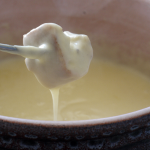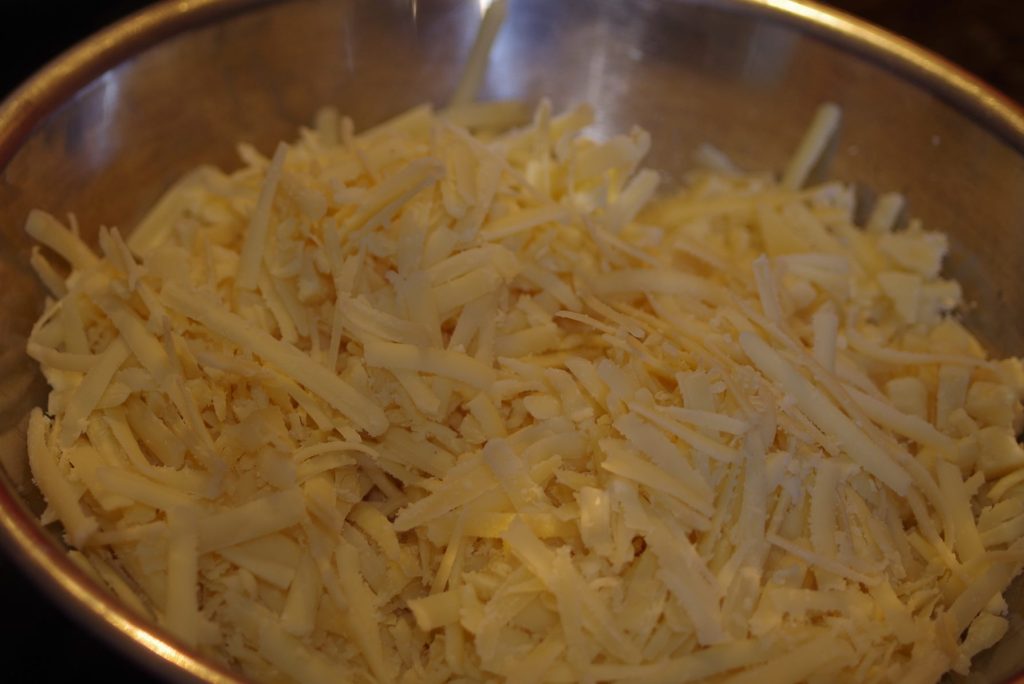How to make CHEESE FONDUE
everything you need to know
Every useful thing learned from eating hundreds of fondues, making up to 12 at a time, having to adapt to the UK and watching Robb learn.
-
Fondue and Chasselas Special PackFondue cheese + wine, delivered together - new batch!
From £20.00
To £325.69
Out of stockCountry: SwitzerlandVariety: ChasselasVintage: NV -
Drinking
Let's get the drinking wine out of the way so we can get on with the Fondue making. What to drink with Fondue? crisp, bold but not too aromatic white wine. It needs to be dry and very clean to cut through the cheese.
In Switzerland we traditionally Chasselas. To vary we might go for Doral, Heida, Johannisberg or a sparkling. In Savoie they drink Jacquere.
For people accustomed to high acidity in their white wine, Chasselas can feel "not enough". The Savoie wines will work better for you, as would the Alpine Italy whites.
You can drink red, but follow the same rules as for the white: dry, crisp (we say "crunchy" when it's a red) and unoaked. Gamay, Pinot or a light Mondeuse all fill these roles.
Tools
You will need
- a fondue pot, which is a heavy pot with rounded bottom - see below for alternatives
- a long kitchen spoon for stirring
- a burner and stand to keep the fondue warm on the table - see below for alternatives
- fondue eating forks (long forks with an insulated handle) or normal forks to eat
Ingredients
- 150g / 200g of cheese per person, grated
- 7.5cl / 10 cl of wine per person
- half a teaspoon (flat) of corn starch or potato starch per person diluted in wine or Kirsch, or a full teaspoon of flour per person (in that case, toss with the cheese)
- garlic to taste
- pepper to taste, nutmeg or paprika (optional)
- Crusty bread (or other things) to dip
We'll go through all of these in more details below.
How much cheese? the Swiss go for 200g per person - if you don't usually eat fondue, reduce to 150g of cheese blend and a little less wine - 7.5cl - it's what the French do)
The traditional recipes just says to rub the inside of the fondue pot with a clove of garlic.
We add chopped (or pressed) garlic to the fondue and enjoy "hunting" for the little garlic bits when eating the fondue.
Of course, if you don't really like garlic, skip it altogether, it's fine.
Preparation
1Rub the pot with garlic (we add chopped garlic). Put the cheese in (if using flour as a binding agent, toss it with the cheese at this stage). Add the wine and the (optional) chopped garlic.
2Heat slowly, stirring often. A smooth steady motion in a figure of 8 works quite well. It can take a while to it's nice to have someone around for conversation and a glass of wine to sip.
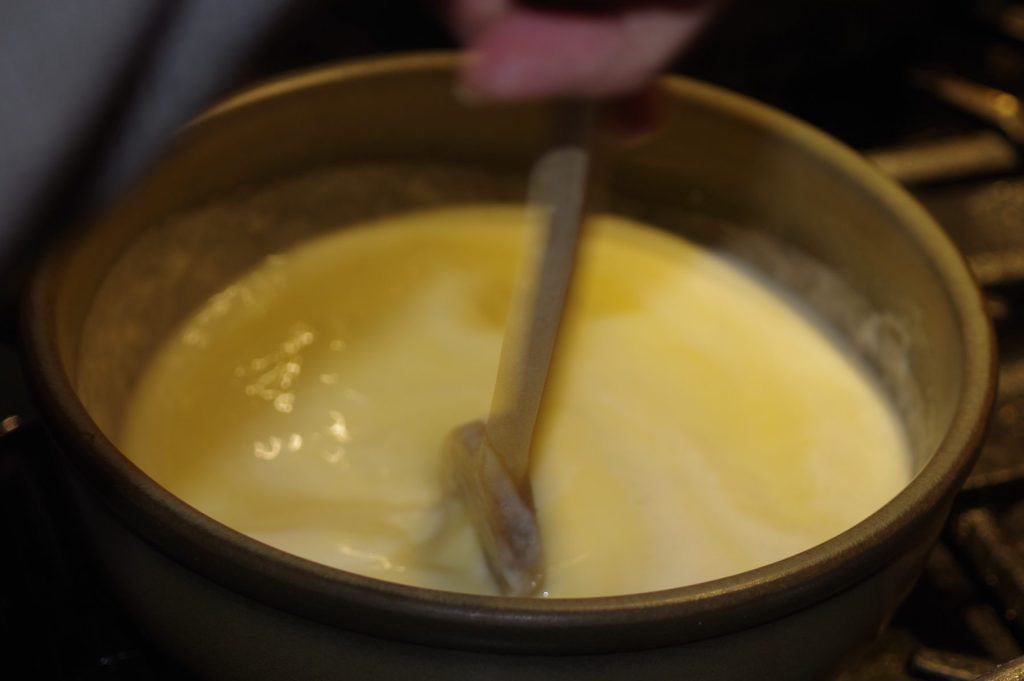
3Once the cheese has started to melt, dilute the corn starch in a little bit of kirsch (or wine/water), and add it to the mix. Keep stirring.
Cheese and wine don't blend smoothly together and will separate if the temperature goes to high or too low or if the fondue is left to sit. That is why people must stir it while eating. The starch helps to keep it smooth.
4The cheese mixture should thicken and bind smooth. Keep stirring regularly as the cheese melts. It must reach "slow boiling" temperature (think witches' cauldron) and turn into a nice thick cheese sauce (note: it will continue to thicken as you eat). If it doesn't bind - which can happen if the cheese is too dry/old - a tiny amount of acidity (dash of lemon, vinegar or mustard) can help.
To finish, add a dash of nutmeg and generous amounts of pepper to taste.
It's now ready to bring to the table.
FONDUE FOR A CROWD? If you are going to make several fondues in parallel, make them together in one big pot and then split the liquid fondue across all the fondue pots at the end. Remember to warm the pots first.
You need a long spoon/stick to stir all the way to the bottom!
Serving
Ready?
Before you bring the fondue to the table, make sure the fire on the burner is lit and the diners are ready with bread on their fork.
Everyone must be sat, poised, bread on, ready to dip in and stir.
No, the fondue won't immediately fall apart if people don't stir, but it is traditional to pretend. The guests' duty is to stir regularly (several slow circuits every time), *never* lose their bread, and enjoy.
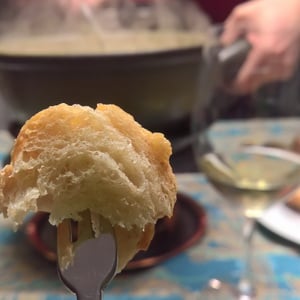
It really helps to have fondue forks, with a long stem (to protect the hands), long teeth and a little notch to keep the bread from sliding. Get the teeth through the crust to make sure it stays put.
Accompaniments - what to serve with Fondue?
In Switzerland traditionally very little is served with Fondue. There would typically be a salad as a starter, and perhaps some pickles and spices on the table.
When we want to be fancy or want to diversify it a bit we have alternative dippers. Good vegetables to dip are celery, cauliflower, broccoli, mushrooms and baby potatoes. Avoid things that will shed or ooze. People also dip cocktail sausages or ham but be warned they tend to flavour the fondue.
You can also add flavouring (dried mushrooms or herbs) to the fondue. This is only a good idea when people have fondue a lot.
In France they make smaller amounts of fondue and tend to pair it with a large platter of crudités, cold cuts, salamis, pickles, pâté to compensate. It's probably a safer approach when your guests have not had cheese fondue before.
Key Ingredients: The Bread

For the bread, you can prepare thick slices in a basket, pre-cut cubes (this will help your fondue novices, making sure there's always a bit of crust), or, for that real rustic feel, let people tear their own chunks.
A crust is a must, you are actively stirring the fondue with your bread. Without any crust the bread could fall apart and get lost in the fondue.
In the UK, you can usually trust the good old "French Stick" to have crust, and not much else.
PS: Whatever size you like is fine. Robb and I do not agree AT ALL on the appropriate size of a fondue bread piece. His are 3x the size of mine.
Lost bread?
It is traditional, in a restaurant party setting, to assume that whoever loses their bread cube (or a big chunk of their bread cube) has to buy the next wine bottle. At home, make up your own penalty. But if everyone's losing their bread, you have insufficient crust.
Key Ingredients: The Cheese
Ask your cheesemonger to make you a fondue blend. They probably already have one, or can grate the cheese mix for you.
Good sources of cheese in the UK are Kaese Swiss online and in Bermondsey, Yumi and the Comté shop in Borough Market and of course specialist cheesemongers like La Fromagerie. If your cheesemonger makes a good mix, let us know!
Note: thanks to brave customers we can report that all the fondue kits available in UK supermarkets are extremely bland. This is to be avoided if you have had proper fondue and want that, but can be a safe introduction to novices. It's usually better to buy supermarket cheese (raclette comte gruyere) and grate it yourself.
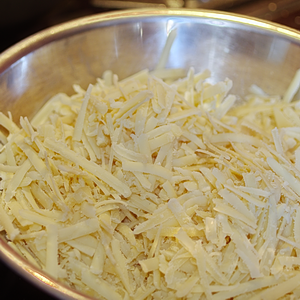
It is fairly easy to make a good blend providing you follow one simple rule:
Half your fondue should be a younger easy melting cheese
Mature cheese does not melt as well so you have to have a "melt-ier" cheese.
In the UK raclette cheese is a good way to get "melt-iness".
In Switzerland the blends are based around Gruyere, with Appenzeller, Vacherin Fribourgeois, Tilsiter or other Alp cheeses in the mix.
The classic "moitié-moitié" if half Gruyere half Vacherin Fribourgeois (100% my terroir of origin). The Swiss germans use local cheeses with Gruyère. I often use raclette/alpage cheese.
In Savoie the blends will focus on Beaufort with Raclette, or Tomme de Savoie. In the rest of France, Comté is the default, often with Emmental (very bland)
Variants:
The "Fondue au Vacherin" is 100% vacherin fribourgeois. It is trickier to make - it needs to be kept at a lower temperature so feels quite cold. It is usually made with milk or water and scooped over potatoes.
The fondue à la tomate is similar but with chopped tomatoes added.
Leftover Fondue?
Fondue can be slowly reheated, with a little extra wine, cheese and starch to rebind. It can be worth "breaking it up" with the fondue forks before, rather than leaving it all as 1 mass.
Key Ingredients: The Wine
What wine to use to make the fondue?
Use a dry, crisp white. Any clean dry white will do. Stay away from oaked wines, sweet wines, or aromatic ones like Gewurztraminer. You can of course use the same wine you are drinking.
But: if you're drinking a really good Fendant, don't waste it in the fondue, use a more generic white.
Cider works in a pinch. I'd probably use cider before I used a heavily oaked white.
Not enough Fondue?
Arriving to the bottom of the pan and still hungry? You could take it back to the cooker and add wine and cheese and make a new batch of fondue on top of the end of the last one.
If that's not an option, break and egg or two in a bowl (depending how much cheese is left), then pour them into the fondue pan, scramble it with the forks so it cooks a little, then eat it with the bread dipped in it. Not quite fondue anymore, but quite tasty.
Myths about eating fondue
Fondue is a heavy meal, and people often overindulge. As a result, many "urban legends" exist about what can make fondue more (or less) digestible. They're pretty much all false.
- A tiny dash of Sodium bicarbonate just at the end can make it fluff up. This supposedly aids digestion. It's traditional, all Swiss have some just for that purpose, but, just like the "don't drink cold water" rule, I don't think it really does anything. I still do it 🙂
- Cold water. Drinking cold water supposedly makes the cheese "block up" in a way tea or wine or kirsch doesn't. This not true, you've just eaten too much. But every few years some clever university students devise another research project to have lots of free Fondue nights by testing this claim.
- A similar claim is made about ice cream as a post fondue dessert, just as untrue. It's fine to eat ice cream if you haven't already overindulged too much.
- Kirsch. It might be traditional to drink a bit of Kirsch or other white spirits with Fondue, or dip the bread in Kirsch before putting it in the pan. It might be fun, but it won't help you digest it better, sorry.
speak swiss romand: "le coup du milieu" a shot of kirsch enjoyed with the fondue.
Tools: Pot and burners
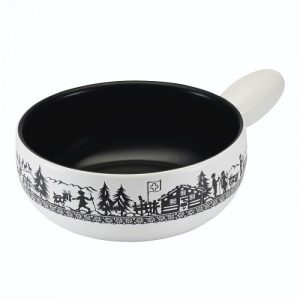
Pot
A fondue pot is traditionally made in clay or enamelled cast iron, with a big handle only used to bring it to the table (and when scraping the rest of the cheese at the end).
Fondue post have rounded edges at the bottom to minimise places where cheese might get stuck and burn.
Of course a normal pan can be used if you're only going to make fondue once. Try to pick one that is wide enough for enough people to dip in, and with high "thermal mass" so temperature does not swing widely. Curved rather than straight edges make it easier to get all the fondue.
Most fondue pots do not work with induction. Induction friendly cast iron ones are not always easy to find but for example the Kuhn Rikon UK web shop usually has a full selection.
Charity shops and auction sites like ebay tend to have a lot of fondue pots.
Burners
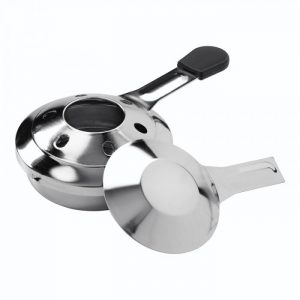
Traditional fondue cookers use little dish burners which burn spirit. Most of them have holes around the side and you can open/close them to control the temperature.
In Switzerland, we use what we call Burning Alcohol (alcool à brûler or Brennspirit). In the UK, this is called methylated spirits. Be careful with these, as a spill from a burning burner can set a tablecloth on fire. Also, never refill them while hot.
Nowadays there is a safer option. The "paste" insets - called fuel paste or fondue gel - are safer and fairly easily changed should you run out but. Good cookshops or ironmongers should have them, but if you don't have a local shop, Kuhn Rikon UK (search for "fuel paste") as well as Ebay (search for "fondue gel") and Amazon are good places to start.
If you cook fondue a lot, you can buy gas burners.
If you don't have a fondue burner a "camping gas" burner could do. And of course a portable electric hotplate at the lowest setting (that's what we use for demonstrations as venues don't like any form of open flame). In a pinch, anything that keeps your pot warm over a couple of tealights.

